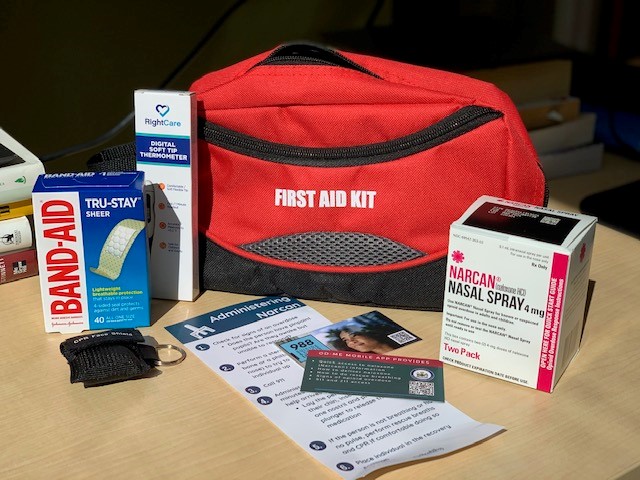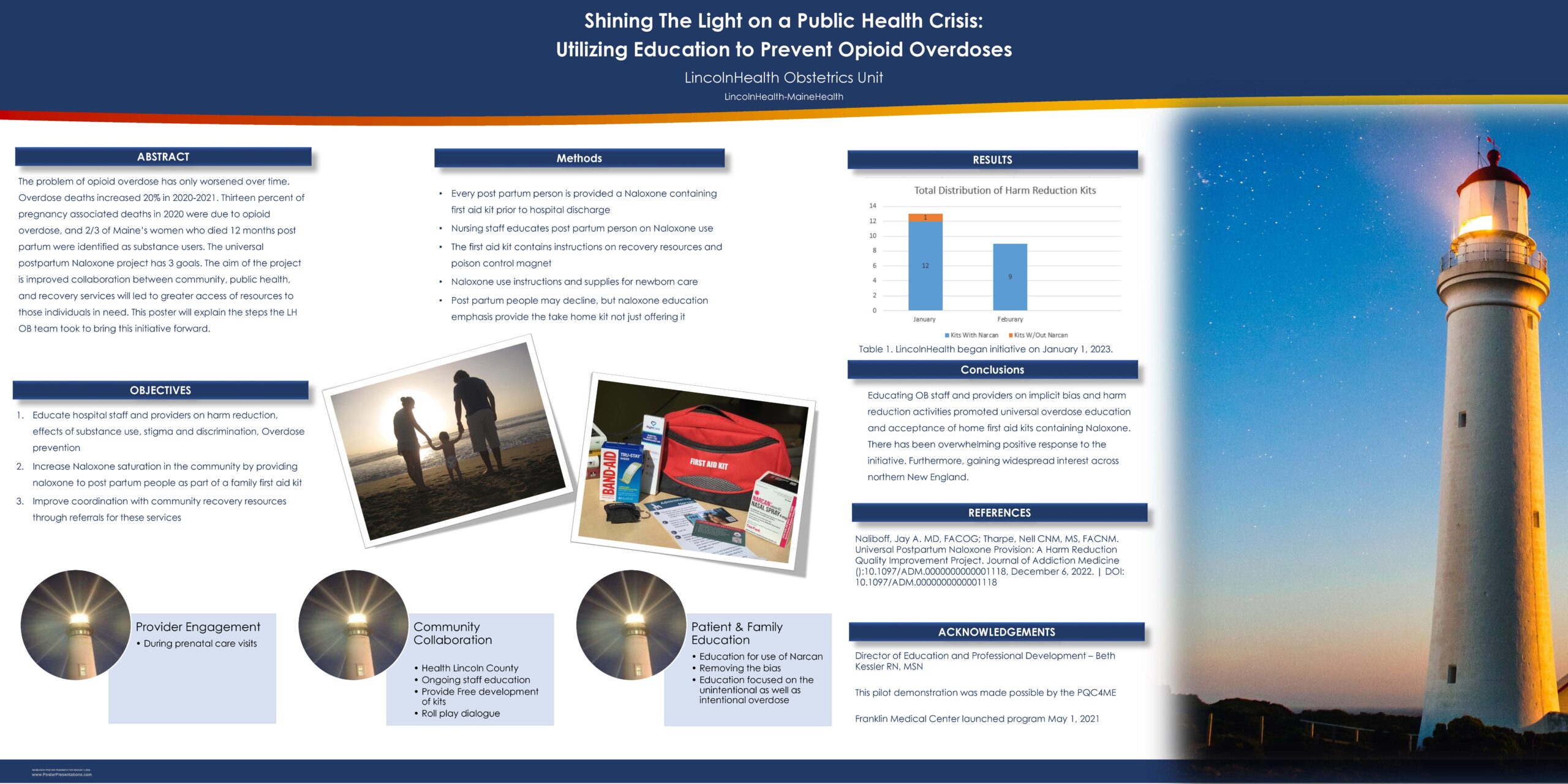As opioid overdoses continue to take the lives of drug users in the U.S., healthcare workers are looking for creative ways to educate the public on the use of naloxone, a nasal spray that reverses the effects of opioids. When used correctly, naloxone can save a life. Naloxone (widely known by its brand name “Narcan”) is more available than ever – even at pharmacies – but most people don’t have it on hand or know how to use it. The staff at the Lincoln Health Birthing Unit decided to change that, one person at a time. They now offer Narcan to every post-partum patient at discharge.
The distribution program has been very successful. Staff simply include the naloxone and instructions for use in a family first aid kit given to all new parents. By including naloxone in the kit, along with band aids, a thermometer and a CPR mask, the hospital normalizes it as a first aid tool and staff are given the opportunity to educate patients on how and when to use it. Staff learn about the kits during their employee training, so distributing the kits has become a routine part of post-partum care. Patients can decline the naloxone, but most patients choose to bring it home with them. In the first two months of this year, 21 of 22 patients chose to bring home the naloxone. The kits are grant-funded or free from Healthy Lincoln County, and the naloxone is provided free by the state.
The naloxone kits were first piloted at Franklin Memorial Hospital’s birthing unit in 2021-22 by Nell Tharpe, CNM, and Dr. Jay Naliboff, members of the Perinatal Quality Collaborative for Maine (PQC4ME). PQC4ME is an initiative under the Maternal Child Health programs at the Maine Medical Association Center for Quality Improvement. PQC4ME is a stakeholder and member driven collaborative. PQC4ME’s Universal Postpartum Naloxone Distribution Program has three objectives: educate hospital staff and providers on the effects of stigma and implicit bias, educate birthing families on overdose recognition and naloxone use, and improve coordination with community harm reduction resources. They accomplish this by connecting community agencies and birthing unit staff while increasing naloxone saturation in the community through distribution of the first aid kits. PQC4ME works in collaboration with Healthy Lincoln County and the Healthy Community Coalition at Franklin Hospital to make sure that naloxone is distributed into the community where it is most needed.

Samples of the first aid kits given to all new parents.
In 2022, there were 10,110 opioid overdoses in Maine, up 14 percent from the previous year. Also in 2022, 2 out of 10 people (20 percent) who died during pregnancy or within 12 months of giving birth did so due to an opioid overdose. New parents are uniquely situated to be presented with a first aid kit, as they want to provide a safe home for their newborn and are in the age range most affected by substance use. Initially staff planned to give patients prescriptions for naloxone, but they knew that new parents might not have the time or inclination to fill it and that stigma around opioid use might prevent them from bringing the prescription to a pharmacy, especially for families not directly affected by substance use. Some Emergency Departments give out or prescribe naloxone, but it’s generally not a universal program, and focuses on people with opioid use disorder. In addition, prenatal and birthing units have a unique educational setting where people can learn about the program over the course of their pregnancy in preparation for receiving the kit upon hospital discharge. Distributing the kits with naloxone at the bedside opens the door to talking about accidental poisoning or overdose from opioids, helps reduce stigma and makes the decision to bring naloxone home easier for parents. While the naloxone can be used within the family, if needed, the goal of community distribution is that naloxone is used wherever opioid overdose reversal is needed. By raising awareness of the signs and symptoms of opioid overdose and equipping families to give naloxone more people are prepared to save a life.

Shining theLight on a Public Health Crisis: Utilizing Education to Prevent Opioid Overdoses. View poster PDF >
“We’re pleased by how receptive and even enthusiastic our staff has been with distributing the kits and educating patients. They see the need for naloxone in the community and understand that it’s a preventative measure designed to help anyone who may need it. We’re really grateful for their willingness to make this program a success.”
– Angela Russ, Nurse Manager, Obstetrics, LincolnHealth
Next Steps
The PQC4ME team is surveying kit recipients to see what they did with the naloxone – whether it was used, given away, lost or discarded. They will use the data to inform future distribution efforts and expansion of the program across the state of Maine. The team has presented this program and their findings nationally and have had multiple organizations from other states express interest in the program. The team will continue to educate and share success and best practices with others.
Collaborators
- Angela Russ, Nurse Manager, Obstetrics, LincolnHealth
- Norma Dawson, LincolnHealth
- Nell Tharpe, CNM, MS, FACNM, Consultant PQC4ME
- Jay Naliboff, MD, Consultant PQC4ME
- Mariah Pfeiffer, Project Manager PQC4ME, Maine Medical Association Center for Quality Improvement
- Beth Kessler, RN, MSN, Director of Education and Professional Development, LincolnHealth
- Will Matteson, Substance Use Prevention Coordinator, Healthy Lincoln County
Our Purpose
MaineHealth Innovation builds connections to drive diversity of thought, educates to produce creative problem-solvers and funds to accelerate ideas. By leveraging the ideas, insights and expertise of all care team members to develop novel solutions to our unmet care needs, we are working together so our communities are the healthiest in America.
